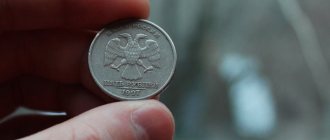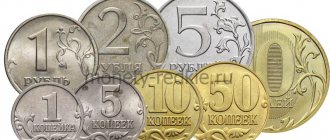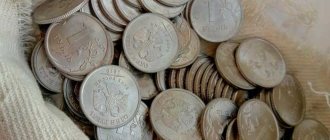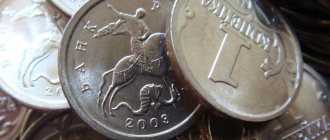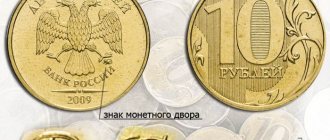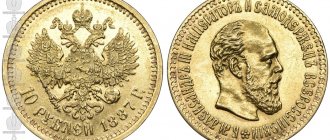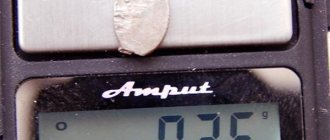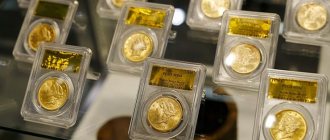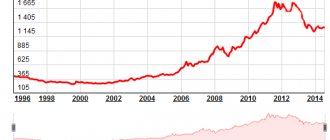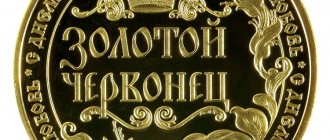1 ruble coins in circulation in modern Russia have been issued since 1997. Over the years, the obverse design has changed twice. The most significant changes occurred in 2016, when instead of the symbol of the Bank of Russia, the coat of arms of the Russian Federation appeared on the front side. You should also know that in order to reduce production costs, in 2009 the material from which coin blanks are made was replaced - from copper-nickel alloy to nickel-plated steel. For this reason, rubles have become magnetic since mid-2009.
Important! All prices are approximate, the actual sale price may differ significantly from the indicated price. More information about prices.
All coins were minted by two mints (branches of Goznak). The Mint, located in St. Petersburg, leaves a mark on rubles in the form of the letters “SPMD”; the Moscow factory designates its products with the letters “MMD”. The mint mark is located under the eagle's claw on the obverse.
MMD:
SPMD:
1 ruble 1999
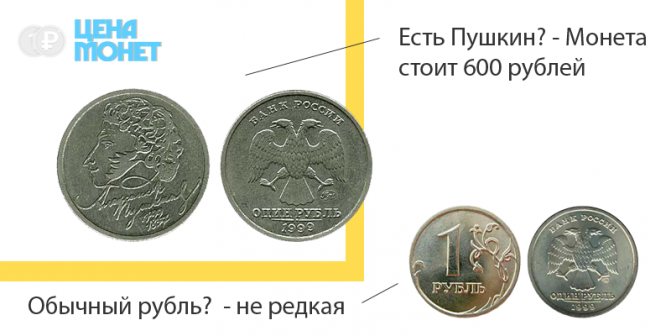
In 1999, two types of one-ruble coins were put into circulation, both commemorative and regular. A typical ruble is not rare, regardless of the mint; even in perfect condition, such a coin costs no more than 30 rubles.
But the anniversary coin is already more interesting, both from an aesthetic point of view and financially. The coin is dedicated to A.S. Pushkin. It was minted at both mints, both MMD and SPMD. This coin is quite common, but in perfect condition it is no longer so easy to find. Therefore, collectors are willing to pay 500-600 rubles for it. By the way, it is important for numismatists to have both Moscow and St. Petersburg coins in the collection.
Bimetallic coins value table
The first group includes bimetallic anniversary coins of 10 rubles. They are also called “bimetal” for short, two-color large ones or old-style tens.
The term “bimetal” means that two metals are used to make such banknotes. Blanks for minting tens consist of a cupronickel disk and a brass ring. But since 2021, in order to reduce production costs, both parts of the coins began to be produced from steel with coatings of different colors (the white color of the disc is given by a nickel coating, and the yellow color of the ring is provided by brass).
Two-color ten-ruble coins attract not only the beautiful design of the surfaces and edges (three hundred reefs, two five-pointed stars and the same number of inscriptions “ten rubles”). They impress with dimensions worthy of modern banknotes - 27 mm in diameter and 2.1 mm thick.
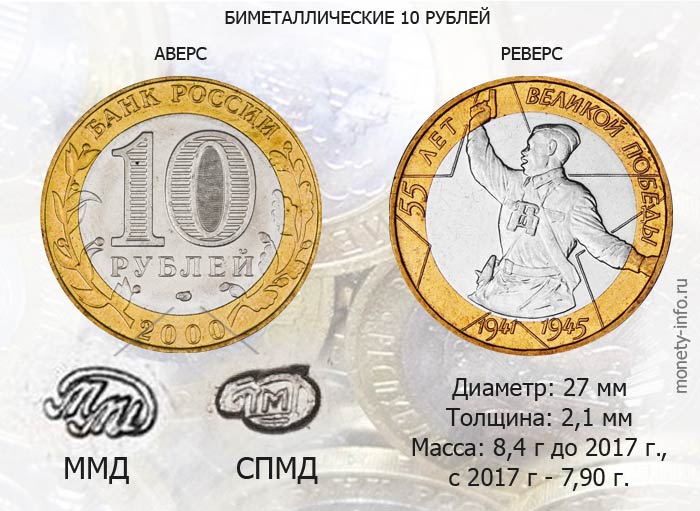
The table contains abbreviations: SPMD - St. Petersburg Mint, MMD - Moscow Mint. This division of prices between mints is necessary, since some issues were divided between two enterprises, which affected the cost. The sign of the company that minted a particular coin can be found on its obverse.
The list of bimetallic tens is represented mainly by three large cycles (“ministries”, “ancient cities of Russia” and “Russian Federation”), as well as several mini-series and non-serial issues.
Table with a complete list of releases by year with prices:
| Year | List | MMD | SPMD |
| 2000 | 55 years of Victory | 60 | 100 |
| 2001 | Gagarin | 70 | 120 |
| 2002 | Armed forces | 120 | — |
| Ministry of Foreign Affairs | — | 120 | |
| Ministry of Justice | — | 120 | |
| Ministry of Internal Affairs | 120 | — | |
| Ministry of Finance | — | 120 | |
| Ministry of Economic Development | — | 120 | |
| Ministry of Education | 120 | — | |
| Derbent | 150 | — | |
| Kostroma | — | 150 | |
| Staraya Russa | — | 150 | |
| 2003 | Pskov | — | 150 |
| Moore | — | 150 | |
| Dorogobuzh | 150 | — | |
| Kasimov | — | 150 | |
| 2004 | Dmitrov | 150 | — |
| Ryazhsk | 150 | — | |
| Kem | — | 150 | |
| 2005 | 60 years of Victory “No one is forgotten” | 20 | 50 |
| Kaliningrad | 150 | — | |
| Kazan | — | 150 | |
| Mtsensk | 150 | — | |
| Borovsk | — | 150 | |
| Leningrad region. | — | 30 | |
| Tver region | 30 | — | |
| Oryol region | 30 | — | |
| Krasnodar region | 30 | — | |
| rep. Tatarstan | — | 30 | |
| Moscow | 30 | — | |
| 2006 | Belgorod | 150 | — |
| Torzhok | — | 150 | |
| Kargopol | 150 | — | |
| Primorsky Krai | 30 | — | |
| Sakhalin region | 30 | — | |
| rep. Sakha (Yakutia) | — | 30 | |
| Chita region | — | 30 | |
| rep. Altai | — | 30 | |
| 2007 | Vologda | 200 | 200 |
| Veliky Ustyug | 200 | 200 | |
| Gdov | 200 | 200 | |
| rep. Bashkortostan | 30 | — | |
| Rostov region | — | 30 | |
| Novosibirsk region | 30 | — | |
| rep. Khakassia | — | 30 | |
| Lipetsk region | 30 | — | |
| Arkhangelsk region | — | 50 | |
| 2008 | Vladimir | 200 | 200 |
| Priozersk | 200 | 250 | |
| Smolensk | 200 | 200 | |
| Azov | 200 | 200 | |
| Udmurt Republic | 30 | 40 | |
| Astrakhan region | 30 | 40 | |
| Sverdlovsk region. | 30 | 40 | |
| Kabardino-Balkarian Republic | 30 | 40 | |
| 2009 | Vyborg | 150 | 150 |
| Galich | 200 | 200 | |
| Kaluga | 150 | 150 | |
| Velikiy Novgorod | 200 | 200 | |
| rep. Kalmykia | 30 | 40 | |
| Jewish auto. region | 30 | 40 | |
| rep. Adygea | 30 | 40 | |
| rep. Komi | — | 30 | |
| Kirov region | — | 30 |
| Year | List | MMD | SPMD |
| 2010 | Population census | — | 300 |
| Bryansk | — | 100 | |
| Yuryevets | — | 100 | |
| Perm region | — | 3 t | |
| Nenets Aut. env. | — | 300 | |
| Chechen Republic | — | 8 t | |
| Yamalo-Nenets Aut. env. | — | 10 t | |
| 2011 | Dace | — | 100 |
| Solikamsk | — | 100 | |
| Buryatia | — | 50 | |
| Voronezh region | — | 30 | |
| 2012 | Belozersk | — | 100 |
| 2013 | rep. North Ossetia Alania | — | 80 |
| rep. Dagestan | — | 50 | |
| 2014 | Nerekhta | — | 100 |
| Penza region | — | 50 | |
| Saratov region | — | 50 | |
| rep. Ingushetia | — | 80 | |
| Tyumen region | — | 50 | |
| Chelyabinsk region | — | 30 | |
| 2015 | 70 years of Victory "Emblem" | — | 30 |
| Liberating the world from fascism | — | 30 | |
| End of World War II | — | 30 | |
| 2016 | Rzhev | 40 | — |
| Velikie Luki | 40 | — | |
| Zubtsov | 40 | — | |
| Belgorod region | — | 30 | |
| Amur region | — | 30 | |
| Irkutsk region | 30 | — | |
| 2017 | Ulyanovsk region | 30 | — |
| Tambov region | 30 | — | |
| Olonets | 30 | — | |
| 2018 | Kurgan region | 30 | — |
| Gorokhovets | 30 | — | |
| 2019 | 75th anniversary of the Victory (2020) | 30 | — |
| Kostroma region | 30 | — | |
| Vyazma | 30 | — | |
| Wedge | 30 | — | |
| 2020 | Ryazan Oblast | 30 | |
| Moscow region | 30 | — | |
| Kozelsk | 30 | ||
| 2021 (plan) | Gorodets | ||
| Karachay-Cherkess Republic | |||
| 2022 (plan) | Nizhny Novgorod | ||
| Rylsk | |||
| Ivanovo region |
1 ruble 2001
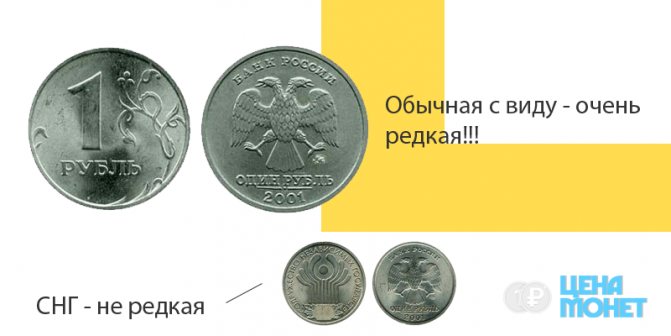
In 2001, only anniversary 1 ruble coins were issued - in honor of the 20th anniversary of the CIS. Regular rubles did not officially enter circulation this year. But many years later, ordinary rubles from 2001 still surfaced. Namely 1 ruble 2001 MMD. Only a few have held or seen this coin. This is more of a mythical coin than a real one. They say that they were allegedly included in the 2002 sets by mistake, but this is not certain.
According to preliminary estimates, such a coin costs more than 500,000 rubles, but its real value can only be determined by an auction and many examinations.
The St. Petersburg coin was never found, but who knows, maybe someday it will emerge from the bottom of the Niva.
As for the anniversary CIS, it is not rare, but if you have it in perfect condition, then it can be sold for 200 rubles.
Rare 1-ruble coins of modern Russia
Almost a quarter of a century has passed since the denomination. During this period, many 1 ruble coins appeared, very interesting and unusual in numismatic terms. In our review, we will ignore varieties that are difficult to identify (for example, 1 ruble 2010, in accordance with the variety catalog, has a couple of valuable varieties on the obverse, but only an expert can identify them), but we will talk about those that are easy to identify.
It should be said that any modern coins of the Russian Federation from the early years of issue, starting from 1997, in stamp shine without mechanical defects, are already worth above their face value. Sometimes even much more expensive. The reason is clear: those who recently started collecting Russian yearbooks want to put perfect coins in the album, but you can’t easily get them in change. Over the two decades that it has been in circulation, the bulk of the money has become very worn out and has long lost its original shine.
1 ruble 1997 MMD
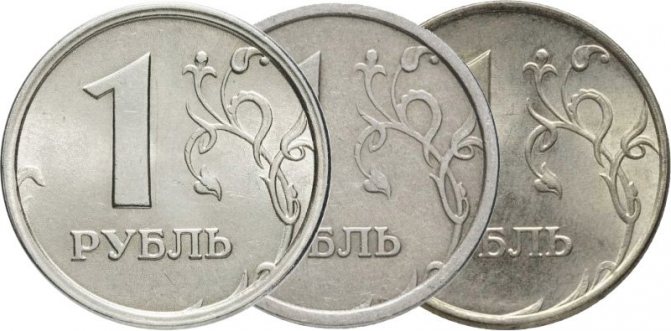
Wide edge with step (left), flat wide edge (center), regular coin (right)
However, worn ruble coins can be expensive if they are a rare variety that is in high demand among collectors. For Moscow rubles with the date “1997” this variety is called “wide edge”. It is difficult to confuse a coin with such an edge with a regular one, even in appearance. But it’s easier to focus on the main sign. An ordinary coin has a gap between the edging and the top sheet of the floral ornament. In valuable specimens, this sheet extends deep under the edge. There are two varieties of “wide edge”: with and without a step. A edging without a step is considered rarer and is valued at a higher price. It should be noted that the coins of St. Petersburg have a visually wider edging than those of Moscow, but the SPMD rubles of 1997 are not rare.
1 ruble 1998 MMD
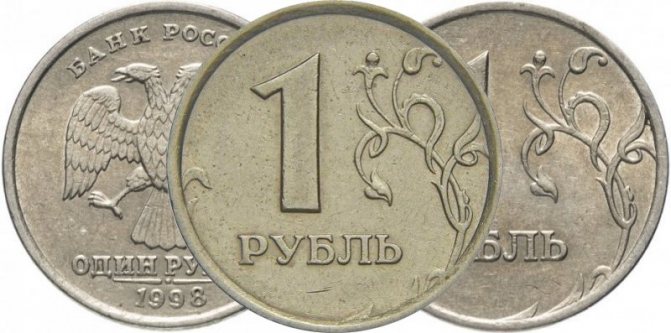
Wide edge (center) and regular coin (right)
The “wide edge” is also present on the 1998 MMD ruble coins, but there it is less pronounced. Here you should examine the coin under magnification. The sign is the same: on a regular coin there is a gap between the edge and the top sheet, but on a rare coin the kat and the sheet are in contact. Any type of “wide edge” 1997-1998. costs several thousand, but the specific price depends on the degree of preservation of the specimen. Moscow rubles also have a lesser-known variety, on which the MMD monogram is located below. However, in collecting circles it is considered infrequent rather than rare, so it will not be possible to get rich on such a ruble, although it is worth more than its face value.
1 ruble 2000 SPMD
Test coin SPMD (2000)
The Bank of Russia in 1999 decided that the already minted coins with the dates “1997” and “1998” were quite sufficient for circulation, so some denominations from the line were not minted en masse at all, while for others the order for minting was reduced. Ruble coins with the date “1999” are rarely found in circulation, but if you carefully examine your change, you can catch them. It was a different matter in 2000, when orders for rubles were not received for either MMD or SPMD. However, the mints were ready for minting. This is evidenced by the trial ruler of the St. Petersburg Court with the date “2000”. Numismatists learned about the existence of these coins almost two decades after they were minted, and there is still little information about them. However, it is known that these are originals, and even reliable photographs of them are available.
1 ruble 2001 MMD
The rarest MMD coin (2001)
We can say that it was with this ruble that the pursuit of rarities began, when Internet pages everywhere called “Don’t miss out on change!!!” But it’s useless to look for such a coin when it’s in change, although according to legend, one of the known specimens was taken out of circulation. And yet, one should not confuse the myth invented to legitimize a unique coin with real life. The legend about the discovery of such a ruble in a set of small change coins from 2002 MMD looks more reliable. The situation still looks strange, since the design of the obverse of ruble coins of 2001 and 2002 is different. It differs not only in date. But it can still be assumed that in such an original way they tried to carry out the removal of rarities from a sensitive facility when control there was impeccable. Among ordinary people, even those far from numismatics, rumors about a rare coin caused a great stir. For this purpose, unknown “masters” set up the production of “rarities”. For the product, they took the anniversary ruble SPMD “10 years of the CIS”, on a high-precision machine they made a recess on the reverse and inserted a ruble of an ordinary year, turned along the edge, there. Collectors call such crafts “glass” and are not in demand. The calculation was precisely for ordinary people who knew about the rare year, but did not distinguish the SPMD emblem (obverse anniversary ruble) from the MMD (obverse unique). Due to its exceptional rarity, the price for 1 ruble of the 2001 MMD, if it appeared at auction, is difficult to predict. You can still find pages reporting that a valuable coin is being sold for 30,000 rubles. Numismatists copy them into the humor section and promise to buy at least a whole bucket of 2001 MMD rubles for this money. By the way, no one has brought the bucket yet.
1 ruble 2002 MMD and SPMD
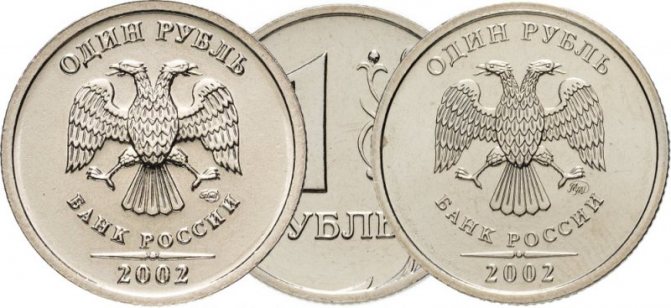
Set coins SPMD (left) and MMD (right)
The Bank of Russia did not order mass minting of ruble denominations next year either. However, each of the mints received an order to mint these coins to complete souvenir sets. For a long time, the sets were on free sale (branded salons of mints, etc.), but did not arouse much interest. The impetus for increased demand and a sharp rise in prices was given by manufacturers of tablet and capsule albums of the Russian weather, where there were corresponding cells for ruble denominations. Numismatic literature indicates that 1, 2 and 5 rubles were minted by each yard in the amount of 15,000 pieces for each position. Therefore, for the Russian Federation, these coins are quite rare. You may notice that Moscow rubles with the date “2002” are slightly higher than St. Petersburg rubles. The difference in price is explained by the design of the sets. SPMD released all sets in a single format, and MMD sets have several options, each of which should be added to the collection of a thoughtful collector of sets of Russian coins. Therefore, it is easier to purchase SPMD coins on the numismatic market. Note that it is not difficult to buy sets of 2002 from both yards (if you do not pay attention to the rather high price), since they are always in stock.
1 ruble 2003 MMD and SPMD
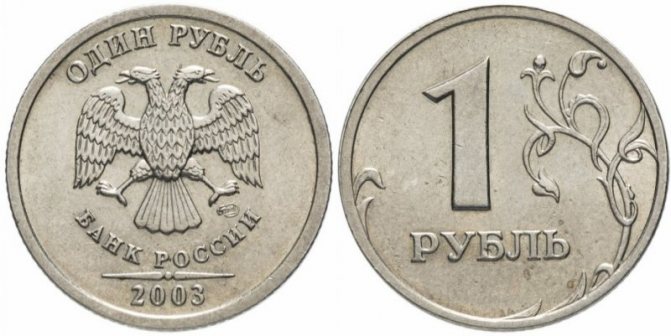
Normal quality of coinage
Next year, the Bank of Russia also planned to release sets of small change coins for both MMD and SPMD. However, due to various circumstances, these sets did not appear (their covers can be seen in our article about valuable coins of 2003). The minted SPMD circulation was in storage for some time, and then an order was received to send these coins into circulation. Rubles of 2003 immediately began to be highly valued among collectors, and the whole country learned about them from the campaign of one of the banks “Find five thousand rubles under the paw of an eagle,” when any client could exchange the 1, 2 or 5 rubles of 2003 brought for the announced amount. Now these coins are more expensive. The price of the ruble denomination is especially high, since it was found less than the other two.
“Proof-like” coinage (SPMD)
It was a great success to catch not an ordinary ruble, but one made using the “Proof-like” technology to complete sets with coins of improved quality. Their share in the total circulation is much less than ordinary coins. Therefore, for the ruble shown above, prices at auctions start from 100,000. The great sadness is that with a long circulation in circulation, a ruble of improved quality quickly loses its unique luster and turns into the most ordinary coin.
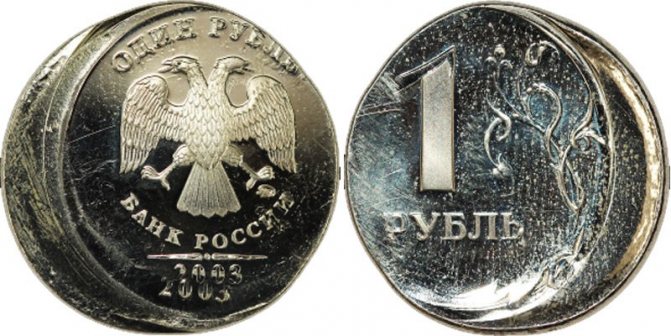
Defective coinage “Proof-like” (MMD)
The fate of the Moscow circulation is much more sad. He was sent for destruction. Hopes that MMD also minted rubles of 2003 appeared almost immediately, since in a report about a rare trinity, 1 ruble of 2003 flashed on the screen, under the eagle’s paw was the rounded monogram of MMD. But, examining the screenshot, experts came to the conclusion that for the report, in the absence of a rare coin, a Moscow steering wheel with a different date was taken, and the video editor corrected the last digit of the date. For a long time there was no information about the circulation of MMD at all. And even now the public can only admire a defective copy, although it was released as “Proof-like”.
1 ruble 2011 SPMD
SPMD Proof Coin (2011)
The trial line of SPMD continues to arouse both interest among collectors and questions about its appearance on the numismatic market. Some of its copies participated in public auctions. Others were acquired privately. And yet, over time, numismatists were able to see high-quality photographs of the complete set. An interesting situation has developed with the 2011 SPMD ruble. Neither of the two unique specimens corresponds to the standards of the mass minted ruble. Since 2009, ruble denominations have been issued on steel blanks with nickel galvanizing. But the SPMD steel magnetic rubles with the date “2011” have a clad surface. Moreover, on one copy (weight 3.11 grams) it is nickel silver (MH19 alloy), which was previously used to clad 1 and 5 kopecks, as well as five-ruble notes. Another specimen (3.07 grams) is plated with nickel silver (MNTs15-20 alloy). There are also different types of reverse. Apparently, even in 2011, experiments on minting everyday coins on blanks of various types continued at SPMD.
1 ruble 2012 SPMD
SPMD Proof Coin (2012)
The catalogs also contain a trial line of SPMD from 2012, where there was no longer room for 5 and 1 kopecks. There is much less information about it, so we can only assume that the characteristics of the 2012 SPMD ruble coincide with the Moscow coin of the same issue date and the same denomination. St. Petersburg coins are not found in circulation, but they are the rarest examples of modern coins.
1 ruble 2021 SPMD
SPMD Proof Coin (2016)
Information about the St. Petersburg Mint’s 2021 line of proof pieces, which included denominations of 1, 2, 5 and 10 rubles, was also extremely contradictory. On the one hand, the information came from an auction, where the last bid for this set reached the amount of 1,277,563 rubles. On the other hand, the pictures from the auction were so blurry that the sharpest eye would not have seen the SPMD logo on the coins. However, after some period, caring numismatists managed to photograph these coins. It's difficult to say how much each of them costs individually. A ruble from this coin series has not yet been put up for public auction separately.
Non-magnetic rubles 2010-2017
Ruble 2010 on the blank of the previous sample
As noted above, in 2009, Russian mints switched to nickel-plated steel blanks for denominations of 1, 2 and 5 rubles. This year, coins of the old version were also issued (1 ruble was minted from nickel silver). Since 2010, according to the rules, only steel blanks were supposed to be used, but here and there coins with new dates began to appear, but on old non-magnetic blanks. For example, the non-magnetic 1 ruble 2010 SPMD aroused great interest. The coin is still classified as “unique”.
The demand for non-magnetic coins began to decline as their supply increased in the numismatic market. One of the first non-magnetic rubles had the date “2013”, and at auction it was purchased for a fantastic amount - 52,630 rubles. The following year, non-magnetic copies appeared again, but with the date “2014”. One of the early auctions of such a coin ended up selling for 32,310 rubles. The subsequent ones did not gain even that. Almost everyone was confident in the appearance of non-magnetic rubles in 2015, and the forecast, of course, came true. These coins did not reach record heights, being fixed at around 15,000 rubles. This is the average price of all non-magnetic copies of recent years of production, since buying them is not very difficult if you constantly monitor trading platforms.
Mix-up coins
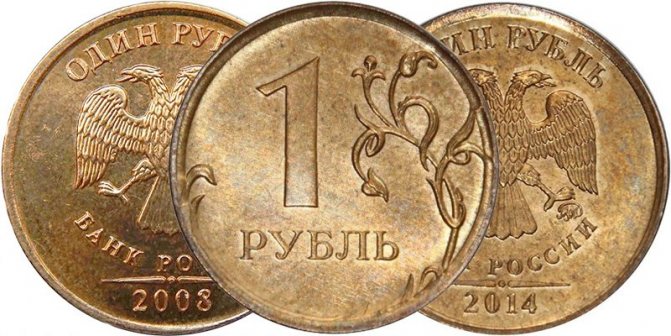
Ruble on the blank 50 kopecks (2008 and 2014)
The first coins, issued simultaneously in a different color and a different metal, caused a huge stir. For the 2008 ruble it turned out to be a yellow magnetic coin, since it was minted on a 50 kopeck blank. In February 2014, such a coin was sold at the Central Forum of Numismatists for 28,200 rubles. Coins with later dates were already classified as “custom-made” products and were not included in many catalogs. The first auctions ended in amounts of 22,000 - 24,600 rubles, but supply increased, and demand began to fall sharply, so the price dropped. True, it is worth noting that at auctions with a high amount of care, coins were offered on blanks of fifty dollars, and prices fell after the market was flooded with yellow rubles made of a copper-zinc alloy.
Bimetallic ruble (2013)
Numismatists were finally convinced of the “custom” origin of unusual coins when bimetallic rubles began to be put up for auction, but such blanks for coins of the Russian Federation simply do not exist (we do not take into account foreign orders from MMD). As a curiosity, the ruble version of the bimetallic coin was at first easily sold at very high prices (for example, it is known that a similar coin was sold for 62,000 rubles), but the market gradually became saturated. True, such a representative of the Kunstkamera cannot be purchased cheaply even now.
Cupronickel ruble showing a comparison of a bunch of rare (left) and regular coins (right)
Among the representatives of the numismatic cabinet of curiosities, which are valued by collectors, we note a completely cupronickel ruble, made on an insert from a bimetallic ten. This coin is distinguished from an ordinary ruble by twice its thickness.
Anniversary rubles of the Russian Federation
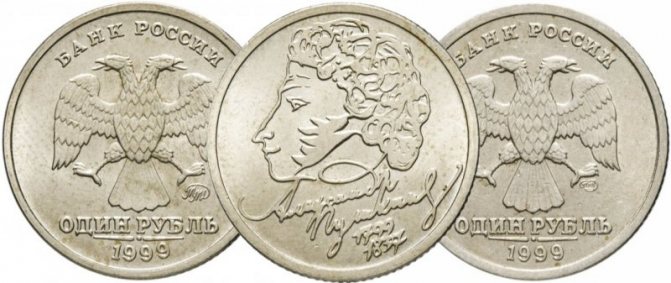
Ruble “Pushkin” MMD (left) and SPMD (right)
If we talk about commemorative coins, there are no particularly expensive items among them, since there are only three of them: “200 years since the birth of A.S. Pushkin" (1999), "10 years of the CIS" (2001) and "Graphic symbol of the ruble" (2014). However, “Pushkins” in good or excellent condition can bring the seller several hundred rubles. With the same mintage among collectors, “Pushkin” minted at the Moscow Mint is valued slightly higher than the same coin from St. Petersburg.
Trial coin “Ruble sign”
If we talk about commemorative coins, there are no particularly expensive items among them, since there are only three of them: “200 years since the birth of A.S. Pushkin" (1999), "10 years of the CIS" (2001) and "Graphic symbol of the ruble" (2014). However, “Pushkins” in good or excellent condition can bring the seller several hundred rubles. With the same mintage, among collectors, “Pushkin” with the MMD monogram on the obverse is valued slightly higher than the same SPMD coin.
Coins 1 ruble from precious metals
Having mentioned commemorative coins made of precious metals, we note that the Bank of Russia also issues silver rubles. They are not initially intended for circulation, although formally they are a payment symbol and are accepted for payment at par. Each of these coins is not cheap, since its price is unlikely to be less than the exchange value of the metal used to make it.
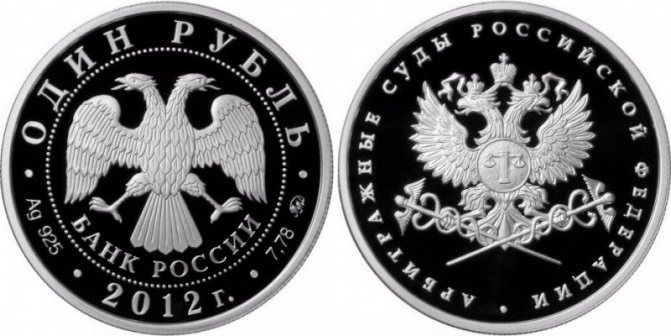
1 ruble 2012 “Arbitrage”
Silver rubles have their own price records. Let us take as an example the 2012 1 ruble “System of Arbitration Courts of the Russian Federation” issued by the Moscow Mint. This is a quarter ounce (7.78 grams) of pure silver. The coin itself weighs more, since 925-carat metal was used for minting. Compared to other silver rubles, Arbitrage is rated highly. In the wake of popularity, bids at auctions jumped beyond 10,000 rubles. In the fall of 2021, the excitement is no longer so high, and this ruble can be bought much cheaper.
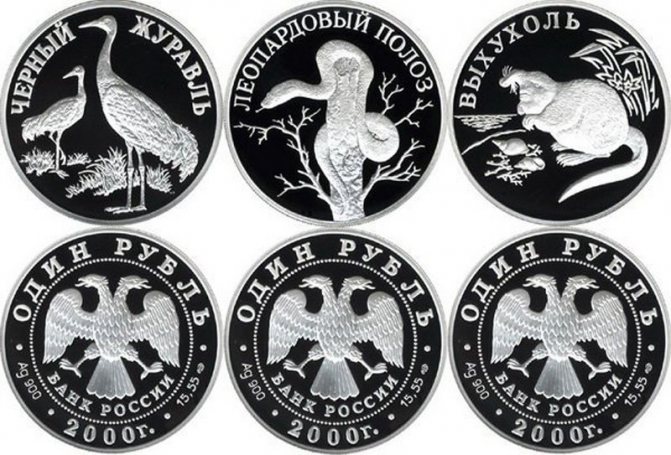
Silver rubles “Red Book” (2000)
For a long time, a deviation from the standard was the “Red Book” series, the rubles of which weighed not a quarter, but half a troy ounce (15.55 grams) with a total coin weight of 17.44 grams. Here, the record holders in terms of value are all three items from 2000: “Black Crane”, “Leopard Snake” and “Muskrat” (the issue was entrusted to the St. Petersburg Mint). The reason for the high price was the unexpectedly low circulation for the silver “Red Book” - only 3,000 pieces.
1 ruble 2002
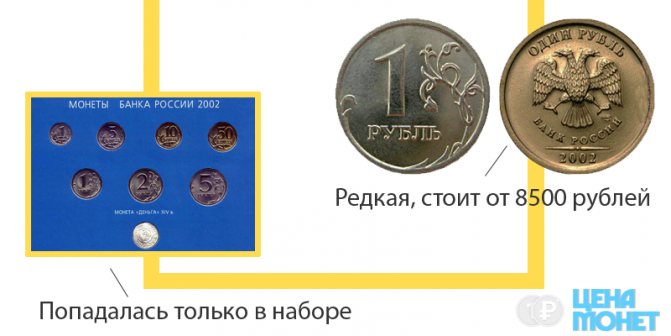
In 2002, coins of denominations from the ruble and above were issued only in gift sets. These are souvenir sets where all coin denominations are presented and a token usually comes with it. Such sets were replicated by both mints. Accordingly, coins can be found both from Moscow and from St. Petersburg.
Rarely did anyone open such sets and sell the coins from them separately, much less put them into circulation at face value. However, there were such cases. And you can buy 2002 coins not only as a complete set. Individually, this year’s 1 ruble coin costs around 9,000 rubles, while the St. Petersburg coin is slightly cheaper – 8,500.
Valuable varieties
Due to adjustments and replacement of working dies during minting, banknotes with slight differences may be issued from one mint. These differences may not even be visible without magnification. But there are numismatists who find and systematize such features. Thus, copies of the same denomination and the same year of manufacture, but having differences are called varieties.
The most famous variety is 1 ruble 1997 with a wide edge. This variety costs from 2 to 8 thousand rubles. The photo shows the difference in the width of the edging of the mass and rare varieties:
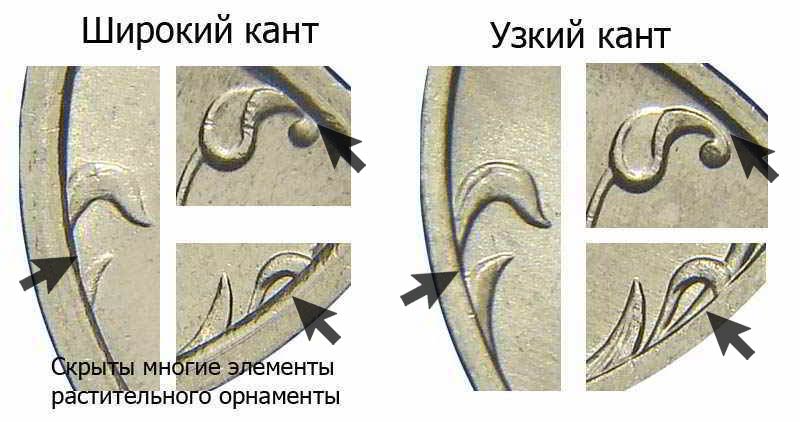
There are other equally valuable varieties, but identifying most of them will require practice and special tools for magnification and measurement. For more information about them, see the links: 1998, 2005, 2007.
1 ruble 2003

Probably everyone has heard about the 2003 coins. At one time, they were even officially bought by one little-known bank, SKB-BANK, and they were bought at an extremely low price of 5,000 rubles. Thus, they made a splash throughout the country, and also made good money.
In fact, the value of this coin is much higher. So 1 ruble of 2003 costs 25,000 rubles today, this is if the coinage is SPMD. The Moscow coin is an extreme rarity, the value of which can only be discussed after an expert assessment.
